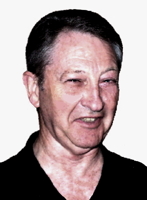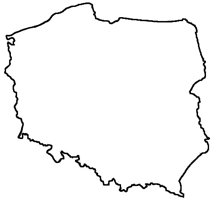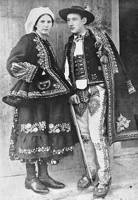
|
The Society of Folk Dance Historians (SFDH)
Choreogeography:
[
Home |
About |
Encyclopedia | CLICK AN IMAGE TO ENLARGE |

|
 Poland's dance is an interesting mix of highly-developed national dances and earthy village dances, with a unique mixture of regional styles, costume, and music. As much as any ethnic dance of Europe, the Poles dance with the entire body, including arms and head, with soft, effortless movements contrasting sharply to erect, vigorous, powerful ones. It's an interesting body of dance, well worth a close Choreogeographic study.
Poland's dance is an interesting mix of highly-developed national dances and earthy village dances, with a unique mixture of regional styles, costume, and music. As much as any ethnic dance of Europe, the Poles dance with the entire body, including arms and head, with soft, effortless movements contrasting sharply to erect, vigorous, powerful ones. It's an interesting body of dance, well worth a close Choreogeographic study.
The country is both blessed and cursed by its location and topography, an easily crossed area devoid of natural obstacles to the many invaders who have trampled it through the centuries as they sought to destroy one another. To the south, the rugged, lovely Tatra Mountains form an impressive boundary with Slovakia and the former Austro-Hungarian Empire. On the north, the Baltic Sea is a major outlet to the world through its many ports.
From the east and west the powerful military cultures of the Ukrainians and Germans came to shed each other's and Polish blood. Anyone with even a smattering of European history knows of the country's troubled past. Polish military history is filled with legends of extraordinary heroism and the tradition of brilliant military horsemanship. Indeed, the horse plays an important role in Polish folklore, as we shall see.
But to the dance . . .
 Men's boots are soft, allowing both great flexibility of technique and protection for strong heel-beats, seemingly a requirement for booted dancers everywhere. Women's boots are frequently laced tight, though the popular "folk dance" style boot is found everywhere. Costumes, as in every other country, are very local and readily identify the wearer's hometown. Polish folk costumes are among the most recognizable in Europe and, in the case of Novy Sącz, among the most elaborate.
Men's boots are soft, allowing both great flexibility of technique and protection for strong heel-beats, seemingly a requirement for booted dancers everywhere. Women's boots are frequently laced tight, though the popular "folk dance" style boot is found everywhere. Costumes, as in every other country, are very local and readily identify the wearer's hometown. Polish folk costumes are among the most recognizable in Europe and, in the case of Novy Sącz, among the most elaborate.
There are five national dances, all highly influenced by professional dance masters. These are "Pan Poland" and exist outside the village dance repertoire. We are most familiar with these national dances, often to the point of ignoring the village dances altogether.
The dances are perhaps most readily approached in order of tempo from slowest to quickest: Polonaise, Kujawiak, Mazur, Krakowiak, and Oberek. Note that the Polka is not one of them, though it is danced throughout the country.
Polonaise – To many Poles, this is the most important dance of all and, perhaps because of Chopin's music, it is possibly the most well known. It opens every ball, led by the guest of honor or the ranking person present, its elegant 3/2 rhythm setting the mood for the evening's festivities. We are informed that the Polonaise was the dance in which all sorts of clandestine arrangements were made. (Maybe that's why it was so important.) Elegance and restraint are the major characteristics, almost pompous in demeanor with bows and curtseys and flirtatious acknowledgments, weaving graceful figures across the floor not unlike the 16th and 17th Century ball dances from which it descended.
Kujawiak – The only dance which attempts to tell a story, the Kujawiak (koo YA vee yak) originated in the impoverished Kujawy region of north central Poland. Its swampy soils were unable to produce abundant crops and its dance reflects the poverty in the sad, lovely strains of its music and in heavy, graceful gestures, a unique character of restrained beauty and free-flowing movement across the floor.
Mazur – The ultimate court dance of old Poland, the Mazur was danced at court in elaborate court dress and brilliant military uniforms by young, fit, energetic ladies and gentlemen. Named for the Mazowsce region in which Warsaw is located, the Mazur perhaps more than any other dance reflects the tradition of horsemanship. The dancer literally flies across the floor in steps and figures designed to mimic the horse and propel one forward in graceful, gliding leaps as one might gallop unhindered across the open landscape.
Listen to this the next time you hear the Mazur: the 3/4 music is accented on the second beat; it's subtle, but it's there and that's why it is so difficult to waltz to what appears to be a waltz rhythm. The reason: tradition has it that the rhythm was influenced by the gait of a galloping horse which begins with a step on one or the other rear hooves (count 1), then the opposite rear hoof and its diagonal front hoof land together (count 2), and the remaining front hoof completes the cycle (count 3), thus the heavier accent on the second beat. Isn't folklore wonderful?
Krakowiak – Obviously from the Krakow region of south central Poland, near the foot of the mighty Tatra mountains, the Krakowiak is the only national dance in 2/4 rhythm. The heel-beats are there, as is the rapid, lateral movement, but now comes a sudden stop, followed by vigorous figures performed in place, as though the horseman came upon the impassable mountains.
Oberek – The fastest and most demanding of the national dances, Oberek means "spinning," and so it does. Its 3/4 rhythm is danced in a unique syncopation, counted "1&-3," a kind of "quick-slower-slow" rhythm which gives the dance a powerful, driving character. Couples spin clockwise in a unique position, the lady on the man's right and holding his upper arm with her left hand as he executes leg sweeps from a deep plie or leaps high in the air at the end of a spin, or tosses his partner high in the air over his shoulder. A great dance for showing off. It frequently appears as a break in the melancholy Kujawiak, a study in contrasts.
Those, academically speaking, are the five national dances of Poland. There are more, however – many more. Among the most well-known and interesting are the dances of the Gorali, mountain dwellers of southern Poland's Tatra mountains, where "kierpce-clad" feet move with unbelievable speed and the dancers move laterally very little. Muscles developed from a lifetime of walking the steeply-sloped land lend an easy power and grace to the mountaineer's dances, alternating deep knee-bends with exhilarating leaps. The "chupaga" (mountaineer's axe) appears prominently in men's dances and couples dances resemble nothing so much as the aggressive courtship of the eagle. No horses depicted here! Poland is thus one of the most demonstrable examples of the effects of topography, history, and livelihood in the way its people live – and dance.
DOCUMENTS
- Poland, a country.
- Richard Duree, an article.
Used with permission of the author.
This page © 2018 by Ron Houston.
Please do not copy any part of this page without including this copyright notice.
Please do not copy small portions out of context.
Please do not copy large portions without permission from Ron Houston.